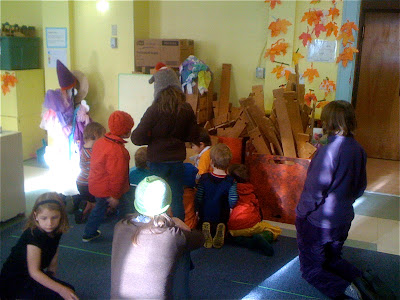From the time we decided last Spring that we would for sure run an afternoon 5's program this year until about mid-summer, I felt quite a bit of pressure to come up with at least a daily schedule to show prospective families. I had kind of an idea, of course, but I dragged my feet as long as I could, reluctant to commit to anything. After all, I'd taught 5-year-olds before, but never an entire classroom full of them. How could I possibly know what would work until I was actually in the midst of it?
One thing I'd not planed on, for instance, was show-and-tell, but on our second day of class, as we convened on our blue rug for circle time, Elena raised her hand and proposed it, saying, "Everybody brings things from their house to show everybody and tell them about it -- show and tell." Her new friends were enthusiastic, so I figured why not? It's a classic early years school activity, providing great public speaking practice, and had the shining virtue of having emerged directly from from the kids. I was tempted, on the spot, to suggest some guidelines, you know, so it didn't get out of hand with the potential for 18 kids bringing something every day, but decided on the spot to let that part emerge as well, in the form of waiting to cross that bridge when we came to it.
 |
| When a kid announces that s/he needs to use the "demonstration zone," everyone turns their backs on me in order to focus on the strip of bare floor just off the other end of the rug. The kids in the front row, kneel, while the ones in the back stand. This is a system they have pretty much worked out on their own. |
By the end of the second week, this activity having become by far the most popular thing we do at circle time, we were standing ready to cross that span. After a day in which we spent over 30 minutes alone on show-and-tell, I wondered aloud if we shouldn't come up with a system by which each child only brought in one item per week. I was surprised when the kids, as a body, were in favor of this, and we devised a system. I informed them that I'd send an email to their parents detailing our agreement, but forgot.
The following day, kicking myself for having forgotten, I braced myself for another long session, but when I looked in to the show-and-tell box, I only saw 5 items. I said, "We only have a few things today."
Wyatt raised his hand, "That's because we're only supposed to bring one thing every week."
I found that hard to believe, frankly. "Really? Hey, raise your hands if you brought a show-and-tell item today."
Five hands went up: the five hands our new system would have predicted. "No way! You guys remembered that? I forgot to send an email to your parents. Now I don't have to. I'm impressed." This was not empty praise.
 |
| The "demonstration zone" is a little crowded on this day, with all those blocks encroaching on the space, but it's pretty impressive the way the kids, for the most part, keep themselves on the rug while their friends share their show-and-tell items. |
For more than a month now, show-and-tell has been self-regulating. Occasionally, a kid or two has violated the system, but only when they have something particularly exciting to show us. What most of the kids seem to be doing is bringing in their favorite/newest toys. We've innovated what we call "the demonstration zone," a piece of bare floor just off the rug, in which, if you have something that requires demonstrating, you have the space in which to show us what you've got. It's a functional, but awkward solution to the children's natural inclination to crowd around. I'm thinking we may have to devise a more formal "demonstration zone," like a large round of plywood, that can be deployed in the center of the blue rug. (We could just make a circle on the rug with tape, but many of the demonstrations involve vehicles which need a harder surface upon which to operate, hence the plywood idea.)
At first, I asked our presenters questions about their items, guiding them through the telling part of the activity, but by now most of them need very little prompting. This means that I am increasingly able to just sit back and let the kids go, which is the gold standard in a play-based classroom.
Yesterday, however, our first day back after the Thanksgiving break, the show-and-tell box was full to the brim, our system having clearly broken down. I'm hoping it's just that there was a lot of pent-up demand after a few days off. It took us 45 full minutes to get through circle time. Forty-five minutes! That's unheard of, yet every one of the kids was engaged, the moving back and forth between the demonstration zone and the "regular zone" apparently serving as enough physical action for the squirrel-ier kids. Forty-five minutes is almost as long as my college classes.
I may still have to send that email to the parents, reminding them of our show-and-tell system, but not yet. Show-and-tell is still evolving, a process that so far has emerged entirely from the kids. There is a real temptation to just let that be our circle time for awhile -- it's what the kids most want to do, there's very little adult "management" required, and we're learning more and more about our friends. Indeed, there are other good things to do at circle time that aren't getting done, but are any of them more important than this?
I put a lot of time and effort into this blog. If you'd like to support me please consider a small contribution to the cause. Thank you!